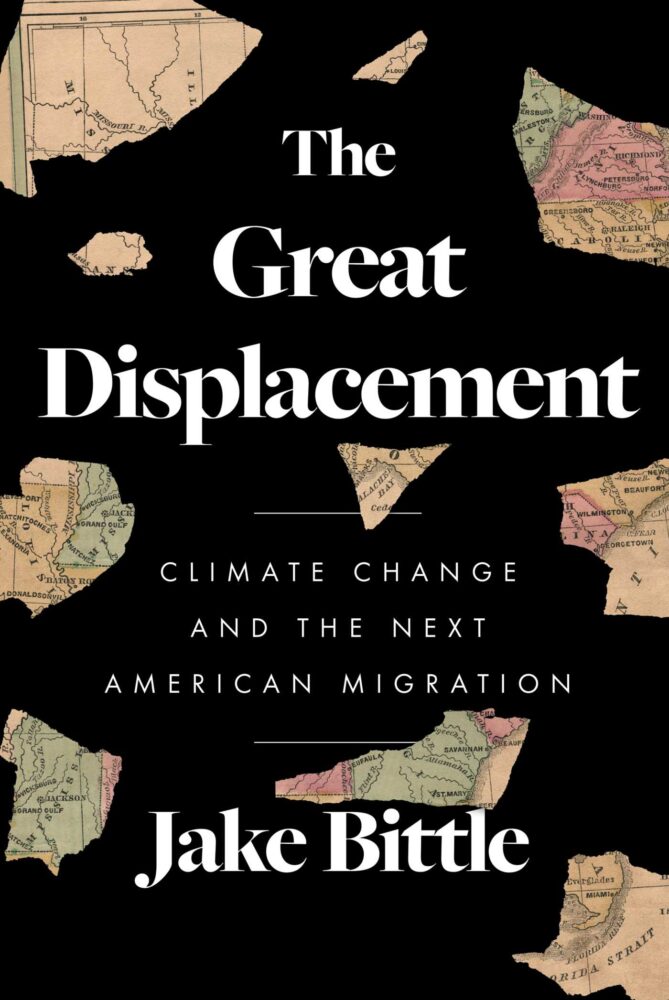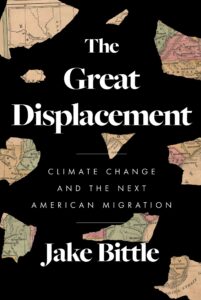Closing Time
A review of Jake Bittle’s The Great Displacement
Published: August 31, 2023
Last Updated: November 30, 2023

Simon & Schuster
If you thought Louisiana would be left out, I have a condo in Cocodrie to sell you. From his many choices of our state’s disappearing towns, Bittle lands on the Pointe-au-Chien community, where lack of federal recognition for the tribe made life precarious even before recent hurricanes. Descendants of Alexander Verdin and Marie Gregoire, an Indigenous woman, have lived in the marsh since the early nineteenth century, but they lacked the paperwork to fight back as the marshland was leased out from under the tribe to oil companies whose rapacious operations only hastened erosion. “In every sense but one, the land around the bayou belonged to the tribe,” Bittle writes. “[T]hey lived on it, traveled on it, shrimped on it, raised cattle on it, trapped on it, and grew their gardens on it. They knew its every intimate detail.”
For each of the communities in which he immerses himself, Bittle paints an environment that’s easy to love, that for long enough seems like paradise to the people who flock there: the trendy bayouside neighborhood in Houston, the cotton boomtown in Arizona, the ocean views of Norfolk. There’s a “possessive love” for home that Bittle tracks across his subjects, a tenacity for personal details and memories, dead relatives, and a place where you’ve carved out some foothold in prosperity and security. In Pointe-au-Chien, Bittle focuses on residents like Chuckie and Alton Verdin, cousins who have faced down hurricanes, school closures, the BP oil spill, and firm federal rejection, and still refused to abandon home.
Writing about disaster on a human scale, Bittle is compassionate toward the people struggling through various indignities in the aftermath of a disaster. He shifts the blame from individuals who’ve chosen to live in apparently dangerous places to the systems that led them there in the first place, as well as the often-insufficient aid following a catastrophe. You’ll come away with a glossary of terms related to disaster preparation and response, many with a bad track record: managed retreat, endangered cultures, fire insurance, climate migration, flood control, buyout programs, housing stock, groundwater replenishment.
Returning home to a stricken place can be exorbitantly expensive; some people can pay that price, while others have no choice but to leave. “When a community disappears,” Bittle observes, “so does a map that orients us in the world.” In Lincoln City, North Carolina, the federal government offered buyouts to residents of a flood-prone historic Black neighborhood to avoid the price of rebuilding in a risky area without a strong tax base. “It may seem counterintuitive,” writes Bittle, “but disasters tend to make people more attached to their homes, not less: rather than taking [Hurricane] Fran as a sign they needed to leave, the residents of Lincoln City determined to hold onto their homes for as long as they could.”
Returning home to a stricken place can be exorbitantly expensive; some people can pay that price, while others have no choice but to leave.
Bittle means for us to see ourselves in these tragedies, an exercise in empathy as well as a warning that your chosen ZIP code may be the next afflicted by rising risks of climate change, bolstered by systemic failure. His project is more than an examination of the immediate aftermath of disasters—it’s also a forecast for where humans might be moving in ever larger numbers, as these major events are perceived less as freak accidents or a dumb Southerner’s comeuppance but rather as a pattern to which we must all acclimate. Temperatures are rising and sea levels too. Disasters will keep pounding at the shore. Where are the high grounds, and can we make room for each other?
Bittle draws his readers to the mostly avoidable issues that compounded the worst moments of people’s lives, and he has handy, too, a set of recommendations for where you might focus your stoked outrage, from addressing “systemic issues in the mortgage and insurance markets” to investing in agricultural interventions and forest thinning. Of course, Bittle notes, “the first step to solving these massive crises will be to acknowledge them as crises.”
We aren’t all leaving tomorrow at daybreak. Bittle’s Louisiana chapter acknowledges as much—that many residents of the most vulnerable places will “hunker down” and hold on, though others Bittle met “never returned to the landscape of blue tarps.”
What is the barrier between those who stay and go? “The land where they made their homes was still solid, still intact, but how long would that last?” writes Bittle of the Pointe-au-Chien people, whose plight may not be unique. “Like visitors from a distant land, they returned to shore bearing fearful messages, and those who had not seen the disappearance for themselves found the stories difficult to believe.”
Lucie Monk Carter is a writer and photographer in Baton Rouge.
